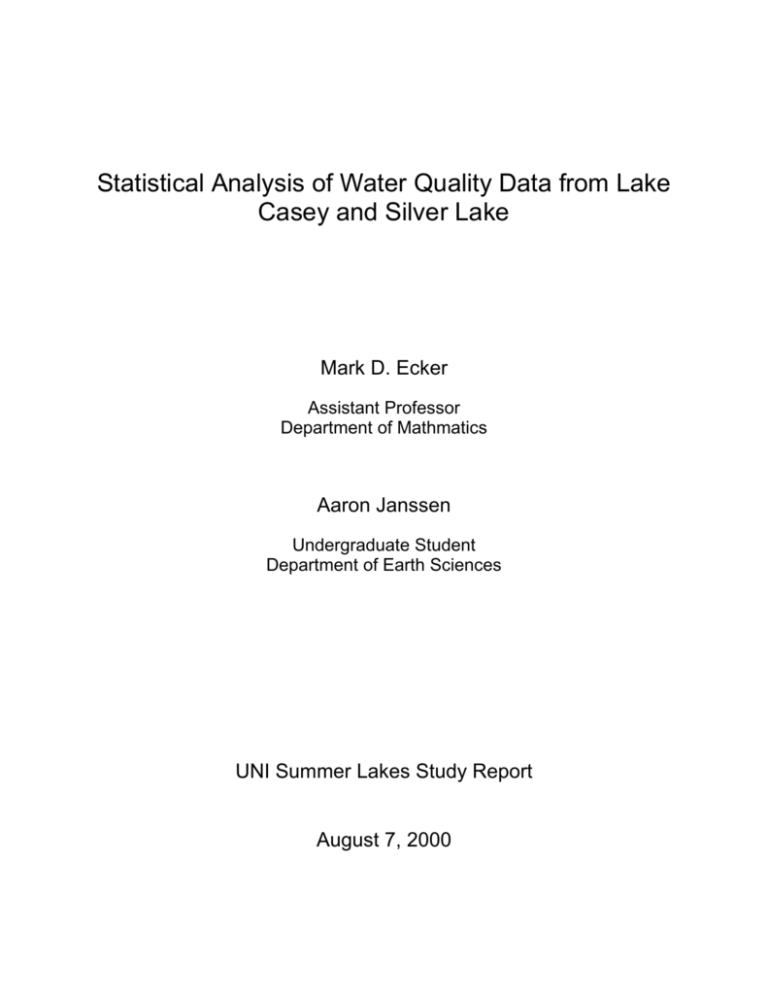Statistical Analysis of Water Quality Data from Lake Casey and
advertisement

Statistical Analysis of Water Quality Data from Lake Casey and Silver Lake Mark D. Ecker Assistant Professor Department of Mathmatics Aaron Janssen Undergraduate Student Department of Earth Sciences UNI Summer Lakes Study Report August 7, 2000 I. Introduction The University of Northern Iowa Summer Lakes Project is composed of a mutlidisciplined team of scientists studying water quality in two Iowa lakes during the summers of 1999 and 2000. During the initial summer, a team of nine University of Northern Iowa faculty and 14 students monitored water quality variables at Lake Casey in Tama county and Silver Lake near Delhi, Iowa. Numerous water quality variables such as dissolved oxygen, phosphorus concentrations, chlorophyll a levels, surface water temperature were collected on nine separate occasions in each lake. The goal of this paper is to provide a statistical analysis of the final 1999 water quality dataset. We shall provide a spatial and spatio-temporal analysis of dissolved phosphorus as a function of the other water quality variables. A purely spatial analysis revolves around the assumption that, for a fixed time point, responses (phosphorus levels) at pairs of sites closer in space tend to be more similar than the responses at pairs of sites further apart. We also will explore for temporal autocorrelation; namely, dissolved phosphorus levels at a particular site tend to be more similar if separated by shorter times intervals (days or weeks rather than months). The paper is organized as follows: Section 2 provides a preliminary analysis of the data while section 3 discusses the purely spatial analysis for several fixed time points. Section 4 outlines the spatio-temporal analysis while conclusions are presented in section 5. II. Preliminary Analyses Water quality variables, dissolved oxygen, total and dissolved phosphorus, surface water temperature and chlorophyll a were regularly measured at most sites in both lakes over the summer of 1999. Other variables, such as nitrate, cyanazine and atrazine levels were measured less regularly; only at some sites and certain times. At Silver lake, 20 sites were sampled on May 28, July 8 and August 2, 1999 and a subset of approximately 10 sites on June 22 and 29, July 12, 19 and 26 and August 9, 1999. Figure 1 shows all 20 sites sampled at Silver Lake. At Lake Casey, water quality variables were collected at 23 sites on May 27, July 7 and August 4, 1999 and at a subset of approximately 15 sites on June 22 and 30, July 14, 21 and 28 and August 11, 1999. Figure 2 displays the 23 sites sampled in Lake Casey. In addition, depth samples of each lake were collected from approximately 300 sites in Lake Casey and 200 sites in Silver Lake. These depths were then interpolated to provide an estimated depth profile for each lake. Figure 3 reveals the depth contours for Silver, whose average depth is 1.765 meters while Figure 4 is for Lake Casey whose average depth is 2.55 meters. In addition, the total volume of water in Silver Lake can be calculated by multiplying the estimated surface water area (128,000 square meters) by the average depth of the approximately 200 sampled sites (1.765 meters) for a total 2 water volume of 225,940 cubic meters. Likewise, Lake Casey has an estimate area of 155,000 square meters and a total water volume of 394,000 cubic meters. III. Spatial Analyses In this section, we perform a geostatistical analysis of phosphorus at two fixed times in Silver Lake and at three time points in Lake Casey. For Silver Lake, we examine dissolved phosphorus on July 8 and total phosphorus on August 2, 1999. In Lake Casey, we explore total phosphorus on June 22, July 14 and August 2, 1999. The standard geostatistical analysis takes place in two steps (see Ecker and Janssen (1999) for a thorough review of the associated theoretical assumptions): semivariogram analysis and kriging. The semivariogram is a measure of the variability of the response (phosphorus) as a function of distance between pairs of sites. It is a measure of the strength of the spatial correlation or spatial association of the data as a function of separation distance between pairs of observations. In general, one would anticipate that pairs of locations closer in space would have more similar responses (phosphorus levels) than that for pairs of sites further apart. A theoretical semivariogram is fitted to the sample semivariogram calculated from the data using the algorithm of Cressie (1985) available in the S-Plus SpatialStats package. Figure 5 displays the theoretical exponential semivariogram fitted to the sample semivariogram of total phosphorus data from Silver Lake on July 8, 1999. Distance is plotted on the x-axis, while variability between pairs of observations, aggregated to distance bins, is plotted on the y-axis (Gamma). This figure shows that variability decreases, i.e., the responses become more similar, as the distance between pairs of sites decreases The second stage of the geostatistical procedure is the prediction or kriging of the response (phosphorus concentrations) at an unsampled location within the lake enabling contour maps of phosphorus to be developed. The predicted value (estimated phosphorus value) for an unsampled site, s0 , say, Y ( s0 ) is just the linear combination of responses at surrounding sites or Y (s0 ) i Y (si ) where i 1 . If no spatial correlation were present, then equal weight would be given to each observed value, i.e., i 1n , for all i and Y ( s0 ) would become the sample mean. However, in the presence of spatial correlation, more weight (higher values of i ) are given to responses at closer surrounding sites to s0 . The exact weights are determined by solving the kriging equations (see Cressie 1993) which heavily depend upon the modeled theoretical semivariogram from the first stage of the geostatistical analysis. Figure 6 presents the kriged dissolved phosphorus map for Silver Lake on 7/8/99 using the theoretical semivariogram fit in Figure 5. There appears to be a spatial gradient with lowest values in the NE corner of the lake and highest occurring in the southwest near an aerator. A strength of the kriging procedure is its ability to assess the error associated with the prediction. As expected, the largest error in predicting 3 phosphorus concentrations is found in locations furthest from the 20 sampled sites, i.e., in the southwestern section. Figure 7 displays the kriging results from total phosphorus on 8/2/99. The highest concentrations are on the NW side to the narrowest section of the lake (roughly in the center of the lake). Figure 8 shows the total phosphorus in Lake Casey on August 2, 1999. The highest concentrations are in the northwestern section of the lake while the lowest are in the westernmost inflow. Also, the kriging errors are highest in the center of the lake; as before, the locations furthest from sampled sites. Figure 9 displays the total phosphorus in Lake Casey on June 22 and July 14, 1999. IV. Spatio-Temporal Exploration of Silver Lake In this section, we present a spatio-temporal analysis to assess whether spatial and/or temporal correlation is present in the 1999 Silver Lake data. Our response variable is dissolved phosphorus and time varying covariates include surface temperature, chlorophyll a and dissolved oxygen. We first fit a standard multiple regression model of all 71 available site and time combinations with complete records, i.e., having measured the four predescribed variables. Table 1 shows the results; the model fits well with an overall R2 of 0.428. Surface temperature and dissolved oxygen are strongly significant, while chlorophyll a is not. Surface temperature has a direct relationship to dissolved phosphorus while dissolved oxygen is inversely proportional to dissolved phosphorus concentrations. Table 1: Multiple regression results Variable Intercept Surface Temperature Chlorophyll a Dissolved Oxygen Parameter Estimate -221.116 16.862 Standard Error 75.645 3.105 t Statistic -2.923 5.594 P-Value 0.051 -10.863 0.053 1.792 0.966 -6.060 0.3377 0.0000 0.0047 0.0000 Using the residuals from the regression model we first explore for temporal correlation and then for spatial correlation. All four variables were measured at eight of the 20 Silver Lake sites (T1S1, T2S1, T2S2, T2S4, T4S1, T4S4, T5S1, T5S4 - or sites 1-8, respectively, from Figure 1) for 6 or 7 of the ten weeks. Temporal autocorrelation is measured by the autocorrelation function (ACF) plot. Lag or time discrepancy between pairs of sites is plotted on the x-axis with correlation 4 on the y. Figures 10-11 show the ACF plot for the eight Silver sites. Of course, lag zero shows a correlation of one (all responses are perfectly, positively correlated with themselves!). Interestingly, only the regression residuals at site 1 show any evidence of temporal autocorrelation (which is not significant). Nearly all of the temporal autocorrelation that does exist in the raw data can be explained by the time dependent covariates, as seen in Figure 12 where site 20 was chosen for illustration. The left hand graph in Figure 12 clearly shows (nearly significant at lag one) autocorrelation of the raw data, but such autocorrelation vanishes when examining the residuals of the regression model. Finally, we explore these residuals for spatial correlation. We chose to examine the residuals from 19 of the twenty observations (the 20th site's data record was not complete) collected on July 7. Figure 13 is the sample or empirical semivariogram which does indicate the presence of spatial correlation. V. Conclusions In this paper, we have outlined the perimeter, provided depth contours and estimated the total water volume in each lake. The deepest section of Silver Lake, at approximately four meters, is in the southwestern section. For Lake Casey, the highest depth, at about 6.5 meters, is in the easternmost section. The spatial analysis revealed that the highest dissolved phosphorus levels in Silver Lake on 7/8/99 occurred in the southwestern section while the lowest were in the northeastern part. For Lake Casey, the highest observed levels of phosphorus varied greatly on the three dates when the most sites were sampled. From the results of the spatio-temporal analysis of the 71 space-time locations in Silver Lake with complete records, there is a strong positive relationship between surface temperature and dissolved phosphorus. Also, there is a significant negative relationship between dissolved oxygen and dissolved phosphorus. The spatio-temporal analysis of the residuals from the regression using time varying covariates indicated that any temporal correlation that is present in the raw data can be adequately explained by the aforementioned covariates. However, these independent variables from Table 1 do not completely account for the spatial correlation. Thus, examining individual maps of phosphorus at fixed time points appears to be entirely justified. VI. Acknowledgements The work of both authors was supported, in part, by the Roy J. Carver Trust, the University of Northern Iowa and NASA’s Space Grant 5 VII. References Cressie, N. (1985). Fitting Variogram Models by Weighted Least Squares. Math Geology. 17(5), pp 563-586. Cressie, N. (1993). Statistics for Spatial Data. John Wiley and Sons, New York. Ecker, M.D. and Janssen, A. (1999). Water Quality in Lake Casey and Silver Lake, Iowa; Spatial Modeling and Prediction. Proceedings to the Ninth Annual Iowa Space Grant Conference. pp 1-10. 6







